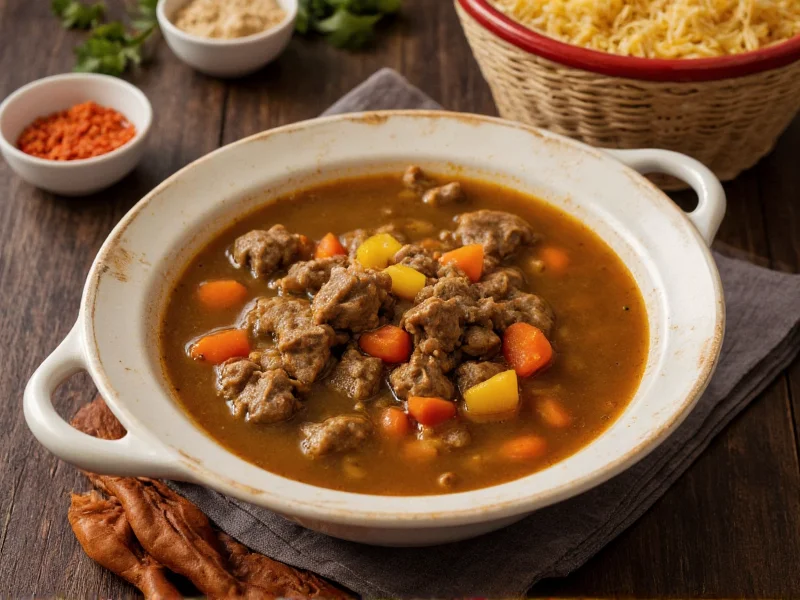Creating exceptional beef soup requires understanding both technique and ingredient selection. This guide explores the culinary science behind perfect beef soup, regional variations, and practical tips for home cooks seeking restaurant-quality results. Whether you're preparing a quick weeknight meal or an elaborate French pot-au-feu, these insights will elevate your soup-making skills.
The Essential Components of Perfect Beef Soup
Quality beef soup begins with three fundamental elements: the meat foundation, aromatic base, and proper cooking technique. The choice between using meaty bones, stewing cuts, or a combination determines your soup's final character. Marrow bones provide collagen that transforms into gelatin during cooking, creating that desirable silky mouthfeel characteristic of well-made bone broth soups.
For optimal flavor development, always sear meat before simmering. This Maillard reaction creates complex flavor compounds that boiling alone cannot achieve. Cut beef into uniform 1-1.5 inch cubes for even cooking, and avoid overcrowding the pan to ensure proper browning rather than steaming.
| Beef Soup Variation | Key Ingredients | Preparation Time | Distinctive Feature |
|---|---|---|---|
| French Pot-au-Feu | Chuck roast, marrow bones, leeks, turnips | 4-6 hours | Served with coarse salt and cornichons |
| Korean Seolleongtang | Oxtail, brisket, roasted onions | 12-18 hours | Cloudy white broth from prolonged simmering |
| American Beef Vegetable | Stew meat, potatoes, carrots, peas | 1.5-2 hours | Hearty weeknight family meal |
| Italian Stracciatella | Beef broth, egg, Parmesan, spinach | 30 minutes | Egg ribbon technique |
Mastering the Cooking Process
The difference between ordinary and extraordinary beef soup often lies in temperature control. Start with cold water when using bones to gradually extract flavors without shocking the proteins. Maintain a gentle simmer—never a rolling boil—as vigorous boiling emulsifies fat into the broth, creating a cloudy appearance and potentially bitter taste.
For healthy beef vegetable soup recipe enthusiasts, add vegetables in stages based on cooking time. Root vegetables like carrots and potatoes require longer cooking, while delicate greens like spinach should be added in the final minutes. This preserves both texture and nutrient content, particularly vitamin C which degrades with prolonged heat exposure.
Nutritional Benefits Worth Noting
Homemade beef soup offers significant nutritional advantages over canned alternatives. The nutritional value of homemade beef soup includes complete proteins, essential amino acids, and minerals like iron and zinc from the meat. Bone-based soups provide collagen that supports joint health and gut integrity. When prepared with diverse vegetables, beef soup becomes a complete meal offering vitamins A, C, and K.
Contrary to popular belief, skimming fat during preparation doesn't significantly reduce calories but dramatically improves flavor clarity. The small amount of healthy fats remaining actually enhances absorption of fat-soluble vitamins from vegetables.
Avoiding Common Preparation Mistakes
Many home cooks make critical errors when preparing easy weeknight beef soup. Adding salt too early can draw out moisture from meat, resulting in tougher texture. Wait until the final hour of cooking to season properly. Another frequent mistake is overcooking vegetables, turning them into unappetizing mush. Consider removing vegetables during simmering and adding them back later if extending cooking time for meat tenderness.
For those using slow cooker beef soup instructions, remember that slow cookers operate at lower temperatures than stovetop simmering. Extend cooking time by 30-60 minutes to achieve proper collagen breakdown, and always sear meat before adding to the slow cooker for maximum flavor development.
Cultural Variations Worth Exploring
Understanding authentic Korean beef soup recipe techniques reveals how cultural approaches differ. Korean seolleongtang requires meticulous attention to bone preparation and extended simmering to achieve its signature milky appearance. In contrast, French pot-au-feu emphasizes precise vegetable timing and traditional accompaniments.
Eastern European beef soup variations often incorporate sour elements like vinegar or lemon juice to balance richness, while Latin American versions might include epazote or cilantro for distinctive herbal notes. Exploring these beef soup with root vegetables traditions expands your culinary repertoire while honoring global soup-making heritage.
Storage and Reheating Best Practices
Proper storage maximizes both safety and flavor retention. Cool soup rapidly by placing the pot in an ice bath before refrigerating. Store in airtight containers for up to 4 days or freeze for up to 3 months. When reheating, do so gently over medium-low heat to preserve texture and prevent ingredient breakdown.
Interestingly, many beef soups taste better the second day as flavors continue to meld. For optimal results when making classic French beef soup preparation, prepare the broth one day and add vegetables the following day before serving.
Perfect Pairings for Complete Dining Experience
Elevate your beef bone broth soup benefits meal with thoughtful pairings. Crusty bread provides textural contrast to tender soup components, while a simple green salad cuts through the richness. For wine pairings, medium-bodied reds like Pinot Noir complement beef soup without overwhelming delicate flavors.
Consider the soup's dominant flavors when selecting accompaniments. Herb-forward soups pair well with garlic toast, while tomato-based beef soups benefit from a dollop of sour cream or grated Parmesan. These thoughtful touches transform a simple bowl of soup into a memorable dining experience.











 浙公网安备
33010002000092号
浙公网安备
33010002000092号 浙B2-20120091-4
浙B2-20120091-4